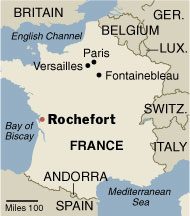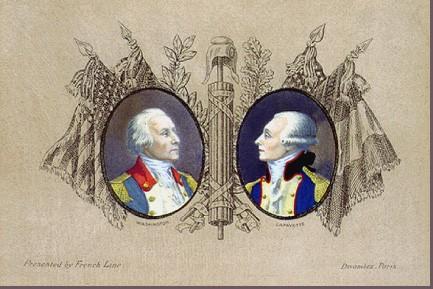
"AQUAE CONDUNT URBES"
Rochefort has many connections with water (fresh water, thermal spring and ocean). On Colbert Place, Neptune and the allegory of the Charente River crown the monumental fountain where the reeds remind of the origins and marshes, like in the "Bassin de Latone" in Versailles. The Trident of Neptune is present at the "Porte du Soleil" (see article: Symbolic porte du Soleil).
"Aquae condunt Urbes" (The waters create the cities - Pliny the Elder), in the Antiquity, the rivers determined the sites of the cities. Rochefort is sheltered in a loop of the Charente River with its fortresses, unalterable sentries to be discovered along the river.
After having selected the mouth of the Seudre River, Brouage, the port of Soubise which had then some importance, Colbert decided to build an arsenal in Tonnay Charente. But the Duke of Mortemart (owner of the land) had a quarrel with Colbert. Another place was searched and Rochefort definitely chosen. So it is because of a lord's bad temper that Rochefort became one of our 5 military ports (with Cherbourg, Brest, Lorient and Toulon). On December 10, 1665, Colbert du Terron, Intendant of the Region Aunis, cousin of the minister, arrives in Rochefort with the Knight of Clerville and several other engineers. The works begin in May 1666. On November 15, of the same year, the Duke of Beaufort, commanding a fleet of 40 ships comes and decommissions in Rochefort and Tonnay. The map of the new city has been drawn after Bordeaux by the Knight of Clerville, the architect Blondel conducting the works on the buildings. The foundations of the Royal Ropery, the forges and the huge storages were then laid.
The arsenal spreads over 2.2 kilometers on the right bank of the Charente River. It should be noticed that none of the 5 military ports of France are mentioned in the Roman Empire and Middle-Ages annals. Their maritime importance does not go back more than the XVIIth century. This is why a monumental design was adopted for the façades of the main buildings oriented towards the river, as well as a symbolism born of mythology in order to recreate the link with the Eternal Knowledge throughout the centuries. Five years after its creation, that is in 1671, 13 ships, 1 galley and several brigantines were built in the port of Rochefort whilst 31 ships were commissioned. In 10 years, 20 000 inhabitants lived in the town.
Rochefort watches the stream of the Charente River, the town also has a spa (saline and ferruginous waters) welcoming 13 000 patients a year. Our town is the 9th hydropathic establishment in France. The waters are recommended to cure rheumatisms, venous sicknesses and in dermatology. The water tower with its nymphaeum reminding of the Grotto of Tethys is surrounded on its façade with balusters indicating the sacred character of the place (photo above) . The project is dated 1866 and the construction by architect Bourgeat lasted from 1872 to 1876. Its capacity is 4 000 cubic meters and was used until 1956. The town also has kept many ancient spout wells. In front of the main façade of the old Navy Hospital is found an artesian well giving thermal and mineral water.
Rochefort and its proto-industrial heritage are a reference today when everyone looks after their roots. The deeply human character of the town makes it even more attractive in many ways.
"AQUAE CONDUNT URBES"
Rochefort rime avec eaux (douce, thermale et salée). Sur la Place Colbert, figure Neptune et la Charente couronnant la monumentale fontaine où les roseaux rappellent les marais des origines, comme au Bassin de Latone à Versailles. Le Trident de Neptune est représenté à la Porte du soleil (voir article Symbolique Porte du Soleil).
"Aquae condunt Urbes" (Ce sont les eaux qui fondent les villes - Pline l'Ancien). En effet, dans l'Antiquité, les fleuves et rivières déterminent le choix des sites urbains. Notre ville est bien abritée dans une boucle de la Charente, avec ses forts disposés en autant d'immuables sentinelles qu'il faut découvrir.
Après avoir songé à l'embouchure de la Seudre, à Brouage, au port de Soubise qui avait alors une certaine importance, Colbert décida de construire un arsenal à Tonnay Charente. Mais le Duc de Mortemart (propriétaire des lieux) se brouilla avec le Ministre Colbert. Il fallut chercher un autre emplacement et Rochefort fut alors définitivement choisi. Ce fut donc la mauvaise humeur d'un grand seigneur qui valut à Rochefort de devenir un de nos 5 ports militaires (avec Cherbourg, Brest, Lorient et Toulon).
Le 10 décembre 1665, Colbert du Terron, Intendant de l'Aunis, cousin du ministre, se rend à Rochefort accompagné du Chevalier de Clerville et de plusieurs autres ingénieurs. Les travaux commencèrent au mois de mai 1666 et furent poussés avec la plus grande activité. Le 15 novembre de la même année, le Duc de Beaufort, à la tête d'une armée navale de 40 vaisseaux vient désarmer à Rochefort et Tonnay. Le plan de la nouvelle ville a été dressé d'après celui de Bordeaux par le Chevalier de Clerville, l'architecte Blondel étant chargé de la conduite des travaux sur les bâtiments. On jeta les fondements de la Corderie Royale, des forges et du grand magasin. L'arsenal s'étend le long de la rive droite de la Charente sur 2,2 kilomètres. Il est à remarquer que sur les 5 ports militaires de France aucun ne figure dans les annales de l'Empire Romain ni dans celles du Moyen-Age. Leur importance maritime ne remonte guère qu'au XVIIème siècle. C'est pourquoi un parti pris monumental fut adopté pour les façades des principaux bâtiments orientés vers le fleuve, ainsi qu'un symbolisme issu de la mythologie, afin de recréer le lien à travers les siècles avec l'Eternelle Connaissance.
Cinq ans après sa fondation, soit en 1671, on construisait dans le port de Rochefort 13 vaisseaux, une galère et plusieurs brigantins, on y arma en outre 31 navires. Et en 10 ans, la ville compta 20 000 habitants.
Rochefort garde le cours de la Charente, la ville possède également des thermes aux eaux salines et ferrugineuses et qui accueillent 13 000 curistes par an. Rochefort est la 9ème ville thermale de France. Ses eaux sont recommandées dans le traitement des rhumatismes, des maladies veineuses et en dermatologie.
Le château d'eau et sa nymphée rappellant la Grotte de Téthys est ceinturé de balustres en façade révèlant le caractère sacré du lieu (photo ci-dessus). Le projet remonte à 1866 et il fut construit de 1872 à 1876 par l'achitecte Bourgeat. Il a une contenance de 4 000 mètres cube et fut en service jusqu'en 1956. La ville a conservé de nombreux puits-fontaines anciens. Devant la façade principale de l'ancien Hôpital de la Marine se trouve un puits artésien d'eau minérale thermale.
Rochefort et son patrimoine proto-industriel font référence, à notre époque où chacun cherche ses racines. Le caractère profondèment humain de notre ville la rend attachante à plus d'un titre.



Aucun commentaire:
Enregistrer un commentaire